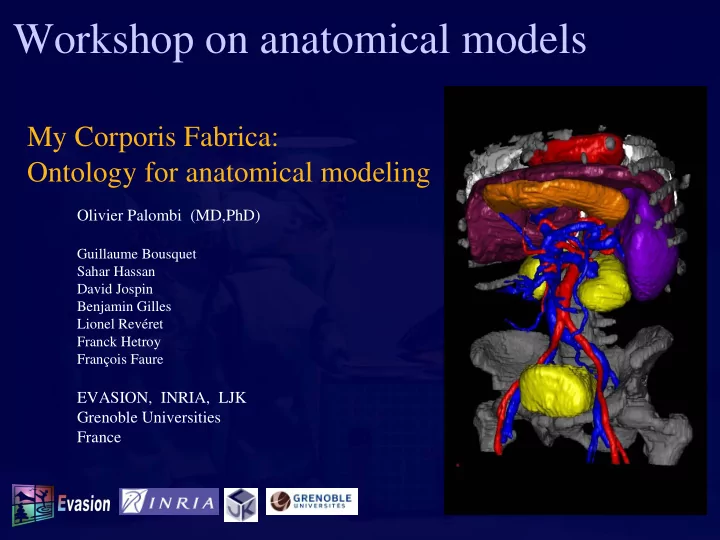

Workshop on anatomical models My Corporis Fabrica: Ontology for anatomical modeling Olivier Palombi (MD,PhD) Guillaume Bousquet Sahar Hassan David Jospin Benjamin Gilles Lionel Revéret Franck Hetroy François Faure EVASION, INRIA, LJK Grenoble Universities France
History of Anatomy Andreae Vesalii (1543) : ” De humani corporis fabrica libri septem ”
Terminologia Anatomica (TA) - 1903: Internationnal Federation of Association of Anatomists (IFAA) is created - 1961: ‘Nomina Anatomica’ (NA) - 1980: Federative Committee on Anatomical Terminology (FCAT) is created - 1989: ‘Terminologia Anatomica’ (TA)
ONTOLOGY Definition : Is a "formal, explicit specification of a shared conceptualization". An ontology provides a computable representation of the underlying reality.
ONTOLOGY COMPONENTS Classes: Abstract objects. Attributes: Properties. Relations: ways in which classes can be related to one another. “The patella is a part of the knee and is a bone organ.” Instances: The general purposes of an ontology is to provide a means of classifying individuals. , even if those individuals are not explicitly part of the ontology.
ONTOLOGY RELATIONS The set of relations describes the semantics of the domain. “The patella is a part of the knee and is a bone organ.” The meronymy relation ( part_of ): Represents how objects combine together to form composite objects. The subsumption relation ( is-a ): This defines which objects are classified by which class.
A FORMAL ONTOLOGY Definition: A Formal ontology is an ontology with a structure that is guided and defined through axioms. = Foundational Ontologies ● indefinite expandability. ● content and context independence. ● accommodate different levels of granularity. Basic formal Ontology (BFO) ( http://www.ifomis.org/bfo ). In biomedicine within the framework of the OBO Foundry
The Open Biomedical Ontologies (OBO) ( http://www.obofoundry.org ) Purpose: ”Creating a suite of orthogonal interoperable reference ontologies in the biomedical domain.” Anatomy in OBO: ● The Foundational Model of Anatomy ontology (FMA) ● The Common Anatomy Reference Ontology (CARO)
The Foundational Model of Anatomy ontology (FMA) ( http://sig.biostr.washington.edu/projects/fm ) FMA contains 75 000 classes and over 120 000 terms; over 2.1 million relationship instances from over 168 relationship types. ● Unified context principle ● Abstraction level principle ● Species specificity principle ● Definition principle ● Organizational unit principle ● Relationship contraint principle ● Coherence principle ● Representation principle
The Foundational Model of Anatomy ontology (FMA) ( http://sig.biostr.washington.edu/projects/fm ) ● Protégé is an authoring and editing environment for ontologies. ● Querying Agent for the Foundational Model of Anatomy (OQAFMA): is a database querying tool that provides access to FMA. Takes StruQL queries as input and returns XML- formatted results. ( http://sig.biostr.washington.edu/projects/oqafma/ )
www.mycorporisfabrica.org Anatomical ontology for mechanical modeling. - Based on FMA - Extensions: - mechanical parameters - geometric informations - functions and process - A new relational database - A specifc GUI
MySQL i mplementation in MyCF
www.mycorporisfabrica.org
Recommend
More recommend